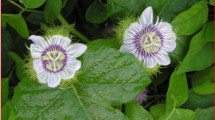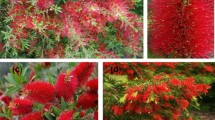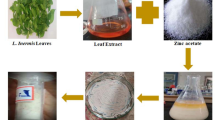Abstract
Artemisia vulgaris is a medicinally important essential oil–yielding plant belonging to Asteraceae, used as a traditional remedy against chronic diseases. The essential oil of this plant has been used as an insect repellent and antimicrobial agent. The growing concern of antibiotic resistance has forced to find an alternative way to control multi-drug-resistant urinary tract–infecting bacterial pathogens by using the essential oil and leaf extract of A. vulgaris for the first time. The antibacterial activity showed that the essential oil (in situ, ex vitro) and leaf crude extract (ex vitro) are highly effective on all human urinary tract–infecting pathogens. In contrast, ex vitro plant-mediated essential oil is most significant with an 18.07 ± 0.17-mm inhibition zone against Klebsiella pneumoniae. The ex vitro plants are also superior to the in situ plants for obtaining greater extract and essential oil content (950 µl), over a time period of 12 wk. To obtain the ex vitro plants, meta-topolin is used for in vitro regeneration of A. vulgaris for the first time, showing the highest mean shoot number (98.11 ± 0.31) regeneration after 42 d, which is more significant in comparison with other studies conducted till date. The cytogenetic stability of the regenerated plantlets has been checked using start codon targeted polymorphism and cytological studies, conferring the homogeneity among regenerants along with in situ plant. Furthermore, the essential oil of the ex vitro plants was analysed through gas-chromatography mass spectroscopy, which detected a few compounds with bio-significance from A. vulgaris, including 2-carene, 2-(4-nitrophenyl) acetamide, β-guaiene, α-acorenol, and 10,12-Tricosadiyonic.






Similar content being viewed by others
References
Afroz M, Akter S, Ahmed A, Rouf R, Shilpi JA, Tiralongo E et al (2020) Ethnobotany and antimicrobial peptides from plants of the Solanaceae family: an update and future prospects. Front Pharm 11:1–15
Ahmad A, Anis M (2019) Meta-topolin improves in vitro morphogenesis, rhizogenesis and biochemical analysis in Pterocarpus marsupium Roxb.: a potential drug-yielding tree. J Plant Growth Regul 38:1007–1016
Aremu AO, Bairu MW, Doležal K, Finnie JF, Van Staden J (2012) Topolins: a panacea to plant tissue culture challenges? Plant Cell Tiss Org Cult 108:1–16
Asima C, Satyesh CP (2001) The Treatise on Indian Medicinal Plants. Publications and Information Directorate, CSIR, New Delhi 4:85–87
Binh NQ, Tung NT, Hanh NP, Truong LH, Cuong NH, Hoai KT, Than NV, Raal A (2021) Chemical composition of essential oils from the leaves, stems and roots of Aristolochia petelotii OC Schmidt growing in Vietnam. J Essent Oil Bear Plant 24:983–989
Blagojević P, Radulović N, Palić R, Stojanović G (2006) Chemical composition of the essential oils of Serbian wild-growing Artemisia absinthium and Artemisia vulgaris. J Agric Food Chem 54:4780–4789
Borzabad RK, Sudarshana MS, Niranjan MH (2010) In vitro plant regeneration from leaf explants of Artemisia vulgaris L.-a medicinal herb. Mod Appl Sci 4:130–134
Chakraborty A, Haque SM, Dey D, Mukherjee S, Ghosh B (2022a) Detection of UTI pathogen-killing properties of Coleus forskohlii from tissue cultured in vitro and ex vitro plants. Proc Nat Acad Sci India Sec b: Biol Sci 92:157–169
Chakraborty A, Haque SM, Ghosh D, Dey D, Mukherjee S, Maity DK, Ghosh B (2022b) Silver nanoparticle synthesis and their potency against multidrug-resistant bacteria: a green approach from tissue-cultured Coleus forskohlii. 3 Biotech 12:1–13
Chakraborty A, Santra I, Haque SM, Ghosh B (2023) In vitro conservation of commercial and threatened members of Zingiberaceae: an Indian scenario. Biodivers Conserv 32:1–41
Chandra H, Bishnoi P, Yadav A, Patni B, Mishra AP, Nautiyal AR (2017) Antimicrobial resistance and the alternative resources with special emphasis on plant-based antimicrobials-a review. Plants 6:1–11
Collard BC, Mackill DJ (2009) Start codon targeted (SCoT) polymorphism: a simple, novel DNA marker technique for generating gene-targeted markers in plants. Plant Mol Biol Rep 27:86–93
Compton ME (1994) Statistical methods suitable for the analysis of plant tissue culture data. Plant Cell Tiss Org Cult 37:217–242
Cristani M, D’Arrigo M, Mandalari G, Castelli F, Sarpietro MG, Micieli D, Venuti V, Bisignano G, Saija A, Trombetta D (2007) Interaction of four monoterpenes contained in essential oils with model membranes: implications for their antibacterial activity. J Agric Food Chem 55:6300–6308
Deans SG, Ritchie G (1987) Antibacterial properties of plant essential oils. Int J Food Microbiol 5:165–180
Ekiert H, Pajor J, Klin P, Rzepiela A, Ślesak H, Szopa A (2020) Significance of Artemisia vulgaris L. (Common Mugwort) in the history of medicine and its possible contemporary applications substantiated by phytochemical and pharmacological studies. Molecules 25:1–32
Fidyt K, Fiedorowicz A, Strządała L, Szumny A (2016) β-caryophyllene and β-caryophyllene oxide—natural compounds of anticancer and analgesic properties. Cancer Med 5:3007–3017
Gantait S, Mitra M (2021) Role of meta-topolin on in vitro shoot regeneration: an insight. In: Ahmad N, Strnad M (eds) Meta-topolin: a growth regulator for plant biotechnology and agriculture, Singapore: Springer, Singapore, pp 143–168
George DP, Roger MD (2000) Encyclopedia of medicinal plants - Education and Health Library. Editoriael Safeliz SL Publishers Spain 2:624
Gilani AH, Yaeesh S, Jamal Q, Ghayur MN (2005) Hepatoprotective activity of aqueous-methanol extract of Artemisia vulgaris. Phytothe Res 19:170–172
Govindaraj S, Diana RKB (2007) Efficient in vitro micropropagation and regeneration of Artemisia vulgaris L. Crop Breed Appl Biotechnol 7:117–124
Govindaraj S, Kumari BDR, Cioni PL, Flamini G (2008) Mass propagation and essential oil analysis of Artemisia vulgaris. J Biosci Bioengg 105:176–183
Grech-Baran M, Pietrosiuk A (2012) Artemisia species in vitro cultures for production of biologically active secondary metabolites. Biotechnologia 93:371–380
Gupta RC, Goyal H, Singh V (2014) Cytology of the genus Artemisia (Anthemidae, Asteraceae) in the Western Himalayas. Biologia 69:1134–1141
Halder T, Ghosh B (2021) Cytological, genetical and phytochemically stable meta-topolin (mT)-induced mass propagation of underutilized Physalis minima L. for production of withaferin A. Biocatal Agric Biotechnol 33:1–11
Hazarika BN (2003) Acclimatization of tissue-cultured plants. Curr Sci 85:1704–1712
Hossain MA, Siddique AB, Rahman SM, Hossain MA (2010) Chemical composition of the essential oils of Stevia rebaudiana Bertoni leaves. Asian J Tradit Med 5:56–61
Jogam P, Sandhya D, Shekhawat MS, Alok A, Manokari M, Abbagani S, Allini VR (2020) Genetic stability analysis using DNA barcoding and molecular markers and foliar micro-morphological analysis of in vitro regenerated and in vivo grown plants of Artemisia vulgaris L. Ind Crop Prod 151:1–9
Judžentien A, Buzelyte J (2006) Chemical composition of essential oils of Artemisia vulgaris L. (mugwort) from North Lithuania. Chemija 17:12–15
Kapoor LD (2000) CRC Handbook of Ayurvedic medicinal plants. CRC Press, Boca Raton
Karabegović I, Nikolova M, Veličković D, Stojičević S, Veljković V, Lazić M (2011) Comparison of antioxidant and antimicrobial activities of methanolic extracts of the Artemisia sp. recovered by different extraction techniques. Chin J Chem Eng 19:504–511
Khan AU, Gilani AH (2009) Antispasmodic and bronchodilator activities of Artemisia vulgaris are mediated through dual blockade of muscarinic receptors and calcium influx. J Ethnopharmacol 126:480–486
Khanam MN, Javed SB, Anis M, Alatar AA (2020) Meta-topolin induced in vitro regeneration and metabolic profiling in Allamanda cathartica L. Ind Crop Prod 145:1–9
Kumar SP, Kumari BR (2010) Effect of amino acids and growth regulators on indirect organogenesis in Artemisia vulgaris L. Asian J Biotechnol 2:37–45
Kundu S, Gantait S (2018) Thidiazuron-induced protocorm-like bodies in orchid: progress and prospects. In: Ahmad N, Faisal M (eds) Thidiazuron: from urea derivative to plant growth regulator, Singapore: Springer, Singapore, pp 273–287
Laha S, Subrahmanyeswari T, Verma SK, Kamble SN, Singh S, Bhattacharyya S, Gantait S (2023) Biogenic synthesis, characterization and application of silver nanoparticles as biostimulator for growth and rebaudioside-A production in genetically stable stevia (Stevia rebaudiana Bert.) under in vitro conditions. Ind Crops Prod 197:116520
Larkin PJ, Scowcroft WR (1981) Somaclonal variation—a novel source of variability from cell cultures for plant improvement. Theor Appl Genet 60:197–214
Lata H, Chandra S, Techen N, Khan IA, ElSohly MA (2016) In vitro mass propagation of Cannabis sativa L.: a protocol refinement using novel aromatic cytokinin meta-topolin and the assessment of eco-physiological, biochemical and genetic fidelity of micropropagated plants. J Appl Res Med Aromat Plants 3:18–26
Lee M, Phillips RL (1988) The chromosomal basis of somaclonal variation. Annu Rev Plant Physiol Plant Mol Biol 39:413–437
Mahanta M, Gantait S, Mukherjee E, Bhattacharyya S (2023) Meta-topolin-induced mass propagation, acclimatization and cyto-genetic fidelity assessment of gerbera (Gerbera jamesonii Bolus ex Hooker f.). S Afr J Bot 153:236–245
Malik S, de Mesquita LSS, Silva CR, de Mesquita JWC, de Sá RE, Bose J et al (2019) Chemical profile and biological activities of essential oil from Artemisia vulgaris L. cultivated in Brazil. Pharmaceuticals 12:1–10
Manandhar S, Luitel S, Dahal RK (2019) In vitro antimicrobial activity of some medicinal plants against human pathogenic bacteria. J Trop Med 2019:1–5
Munda S, Pandey SK, Dutta S, Baruah J, Lal M (2019) Antioxidant activity, antibacterial activity and chemical composition of essential oil of Artemisia vulgaris L. leaves from Northeast India. J Essent Oil Bear Plant 22:368–379
Murashige T, Skoog F (1962) A revised medium for rapid growth and bio assays with tobacco tissue cultures. Physiol Plant 15:473–497
Obistioiu D, Cristina RT, Schmerold I, Chizzola R, Stolze K, Nichita I, Chiurciu V (2014) Chemical characterization by GC-MS and in vitro activity against Candida albicans of volatile fractions prepared from Artemisia dracunculus, Artemisia abrotanum, Artemisia absinthium and Artemisia vulgaris. Chem Cent J 8:1–11
Pandey BP, Thapa R, Upreti A (2017) Chemical composition, antioxidant and antibacterial activities of essential oil and methanol extract of Artemisia vulgaris and Gaultheria fragrantissima collected from Nepal. Asian Pac J Trop Med 10:952–959
Pandey S, Patel P, Prasad A, Sawant SV, Misra P (2020) Assessment of direct shoot organogenesis and genetic fidelity in Solanum viarum Dunal—a commercially important medicinal plant. In Vitro Cell Dev Biol 56:538–547
Ram PR, Mehrotra MN (1995) Compendium of Indian medicinal plants, publication and information directorate, CSIR. New Delhi 4:74
Sakha H, Hora R, Shrestha S, Acharya S, Dhakal D, Thapaliya S, Prajapati K (2018) Antimicrobial activity of ethanolic extract of medicinal plants against human pathogenic bacteria. Tribhuvan Univ J Microbiol 5:1–6
Santra I, Ghosh B (2023) Sustainable production of plumbagin via meta-topolin-mediated high frequency regeneration of genetically true-to-type Plumbago zeylanica L. 3 Biotech 13:1–10
Santra I, Halder T, Ghosh B (2021) Somatic and gametic chromosomal characterization with fluorescence banding of Giloy (Tinospora cordifolia): a berberine synthesizing important medicinal plant of India. Caryologia 74:63–73
Santra I, Haque SM, Ghosh B (2020) Giemsa C-banding karyotype and detection of polymorphic constitutive heterochromatin in Nigella sativa L. Cytologia 85:85–90
Schmidt E, Jirovetz L, Buchbauer G, Denkova Z, Stoyanova A, Murgov I, Geissler M (2005) Antimicrobial testings and gas chromatographic analyses of aroma chemicals. J Essent Oil Bear Plant 8:99–106
Sharmla D, Kotteswari M, Lekhana S, Prabhu K, Rao MR, Balaji TK, Dinakar S, Sundaram RL (2020) The gas chromatography–mass spectrometry study of one ayurvedic medicine, Induppukanam. Drug Invent Today 14:744–747
Singh BR, Singh V, Singh RK, Toppo S, Haque N, Ebibeni N (2011) Antimicrobial effect of Artemisia vulgaris essential oil. Nat Prod 7:5–12
Singh NB, Devi ML, Biona T, Sharma N, Das S, Chakravorty J, Mukherjee PK, Rajashekar Y (2023) Phytochemical composition and antimicrobial activity of essential oil from the leaves of Artemisia vulgaris L. Molecules 28:1–14
Smajlagić A, Srabović M, Ademović Z, Pehlić E, Huremović M, Huseinović E (2020) Synthesis and crystallization of N-(4-nitrophenyl) acetamides. J Chem Biol Phy Sci 11:043–053
Subrahmanyeswari T, Gantait S, Kamble SN, Singh S, Bhattacharyya S (2023) Meta-topolin-induced regeneration and ameliorated rebaudioside-A production in genetically uniform candy-leaf plantlets (Stevia rebaudiana Bert.). S Afr J Bot 159:405–418
Subrahmanyeswari T, Gantait S, Sarkar S, Bhattacharyya S (2022) Accelerated mono-phasic in vitro mass production of banana propagules and their morpho-cyto-genetic stability assessment. S Afr J Bot 146:794–806
Sujatha G, Kumari BR (2007) Effect of phytohormones on micropropagation of Artemisia vulgaris L. Acta Physiol Plant 29:189–195
Sujatha G, Kumari BR (2008) Micropropagation, encapsulation and growth of Artemisia vulgaris node explants for germplasm preservation. S Afr J Bot 74:93–100
Sujatha G, Ranjitha Kumari BD (2007) High-frequency shoot multiplication in Artemisia vulgaris L. using thidiazuron. Plant Biotechnol Rep 1:149–154
Sujatha G, Ranjitha Kumari BD (2012) Establishment of fast growing in vitro root culture system in Artemisia vulgaris. Int J Agric Technol 8:1779–1790
Tajadod G, Mazooji A, Salimpour F, Samadi N, Taheri P (2012) The essential oil composition of Artemisia vulgaris L. in Iran. Ann Biol Res 3:385–389
Teixiera da Silva JA (2004) Mining the essential oils of the Anthemideae. Afr J Biotechnol 3:706–720
Vallès J, Garcia S, Hidalgo O, Martín J, Pellicer J, Sanz M, Garnatje T (2011) Biology, genome evolution, biotechnological issues and research including applied perspectives in Artemisia (Asteraceae). Adv Bot Res 60:349–419
Vallès J, McArthur ED (2001) Artemisia systematics and phylogeny: cytogenetic and molecular insights. In: McArthur ED, Fairbanks DJ (eds) Proceedings of shrubland ecosystem genetics and biodiversity, Provo, UT, pp 67–74
Walter HL, Memory PF, Elvin L (2003) Medical botany: plants affecting human health, 2nd edn. John Wiley and Sons Inc., Hoboken New Jersey
Wang J, Zhu F, Zhou XM, Niu CY, Lei CL (2006) Repellent and fumigant activity of essential oil from Artemisia vulgaris to Tribolium castaneum (Herbst) (Coleoptera: Tenebrionidae). J Stored Prod Res 42:339–347
Weston LA, Barney JN, DiTommaso A (2005) A review of the biology and ecology of three invasive perennials in New York State: Japanese knotweed (Polygonum cuspidatum), mugwort (Artemisia vulgaris) and pale swallow-wort (Vincetoxicum rossicum). Plant Soil 277:53–69
Yang X, Chen H, Zheng Y, Qu S, Wang H, Yi F (2022) Disease burden and long-term trends of urinary tract infections: a worldwide report. Front Public Health 10:1–13
Zeng J, Deng S, Wang Y, Li P, Tang L, Pang Y (2017) Specific inhibition of Acyl-CoA oxidase-1 by an acetylenic acid improves hepatic lipid and reactive oxygen species (ROS) metabolism in rats fed a high fat diet. J Biol Chem 292:3800–3809
Acknowledgements
All authors are thankful to Swami Kamalasthananda, Principal, Ramakrishna Mission Vivekananda Centenary College, Rahara, Kolkata, India, for the facilities provided during the present study. All authors are also thankful to DST-FIST. DB acknowledges the Human Resource Development Group, Council of Scientific & Industrial Research (CSIR-HRDG) for providing CSIR−Senior Research Fellowship. AC, IS, and SM also acknowledge the West Bengal State Government for providing SVMCM fellowship during the study.
Author information
Authors and Affiliations
Contributions
AC, DB, IS, and KB have performed different experiments. AC, DB, and IS have prepared the manuscript. SM, AC, IS, and DB have prepared the tables and figures. AC, DB, IS, and BG have critically reviewed and approved the final version of the manuscript, tables, and figures.
Corresponding author
Ethics declarations
Competing Interests
The authors declare no competing interests.
Rights and permissions
Springer Nature or its licensor (e.g. a society or other partner) holds exclusive rights to this article under a publishing agreement with the author(s) or other rightsholder(s); author self-archiving of the accepted manuscript version of this article is solely governed by the terms of such publishing agreement and applicable law.
About this article
Cite this article
Chakraborty, A., Biswas, D., Santra, I. et al. Phytochemical analysis and anti-UTI activity of essential oil from meta-topolin-induced micropropagated Artemisia vulgaris L.. In Vitro Cell.Dev.Biol.-Plant 59, 584–601 (2023). https://doi.org/10.1007/s11627-023-10380-2
Received:
Accepted:
Published:
Issue Date:
DOI: https://doi.org/10.1007/s11627-023-10380-2




